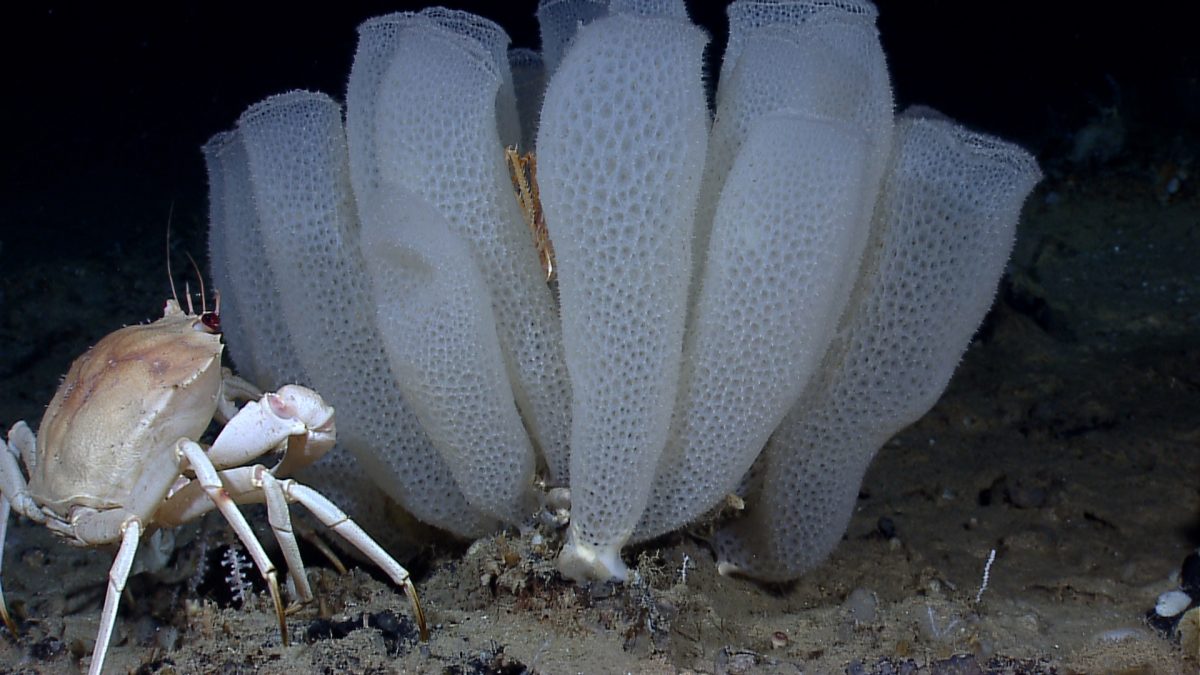Chapter contents:
Porifera
–– 1. Archaeocyatha
–– 2. Stromatoporoidea
–– 3. Demospongiae
–– 4. Hexactinellida ←
–– 5. Calcarea
–– 6. Homoscleromorpha
3D models of Hexactinellida can be found here!
Above Image: A golden crab (Chaceon fenneri) contemplates a spectacular group of Venus flower basket glass sponges (Euplectella aspergillum). Source: NOAA Okeanos Explorer Program, Gulf of Mexico 2012 Expedition (Wikimedia Commons, Creative Commons Attribution 2.0 Generic License).
Class Hexactinellida Snapshot
- Examples: glass sponges
- Ecology: marine
- Key features of group: sycon and leucon body forms, silica (some calcite) hexactine spicules
- Diversity: ~679 living sp.
- Fossil record: Cambrian to Recent
Overview
Hexactinellida are characterized by having siliceous hexactine (six-pointed) spicules, making them the second class within the major sponge group Silicea. They also construct two different body plans: sycon and leucon. Their delicate structures often lack color, which is why this group is referred to as the 'glass sponges' even though they aren't the only silica glass secreting group.
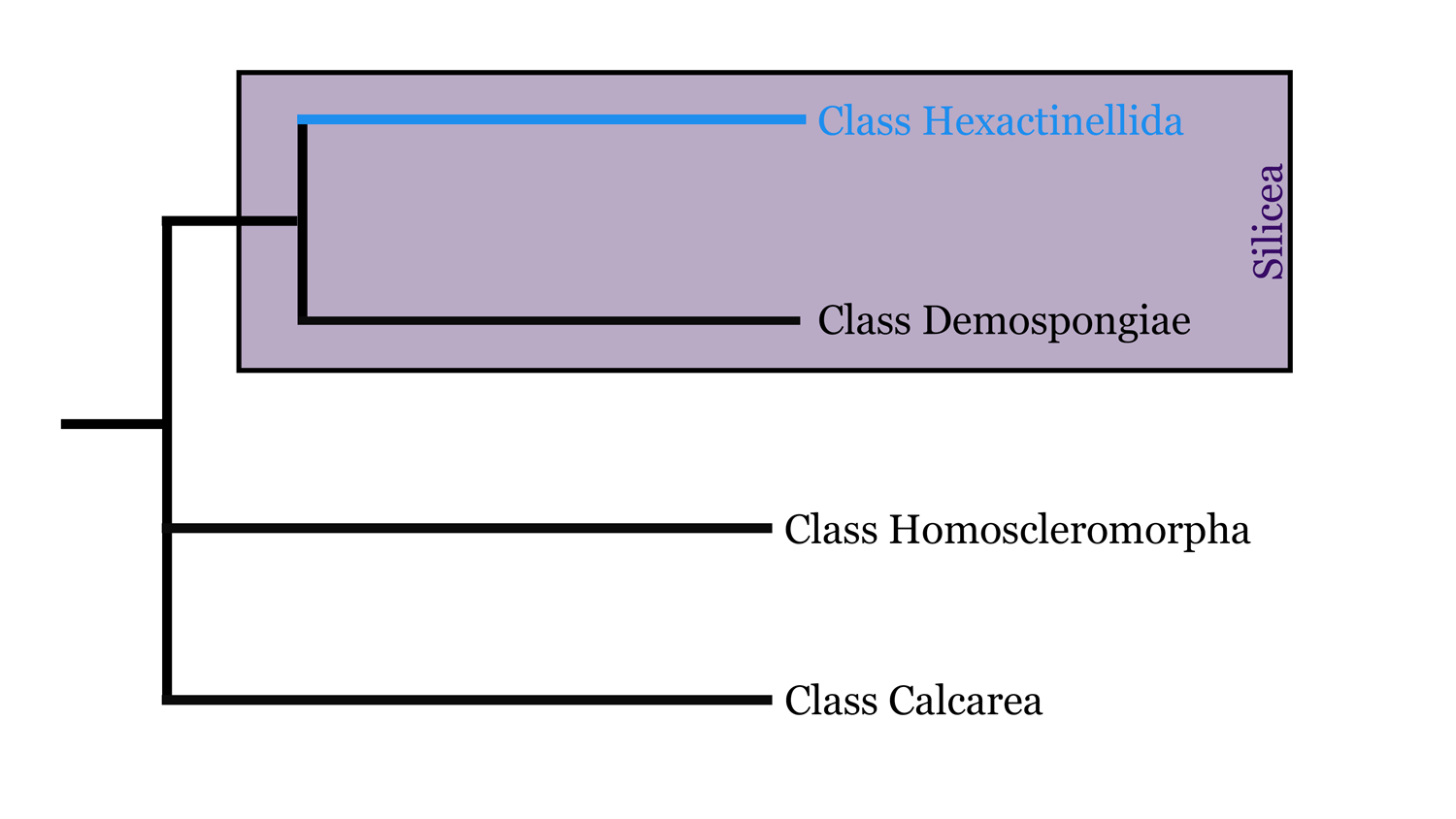
Highly simplified overview of porifera phylogeny based in part on the hypothesis of relationships presented by Botting and Muir (2018). Image by Jaleigh Q. Pier, licensed under a Creative Commons Attribution-ShareAlike 4.0 International License.
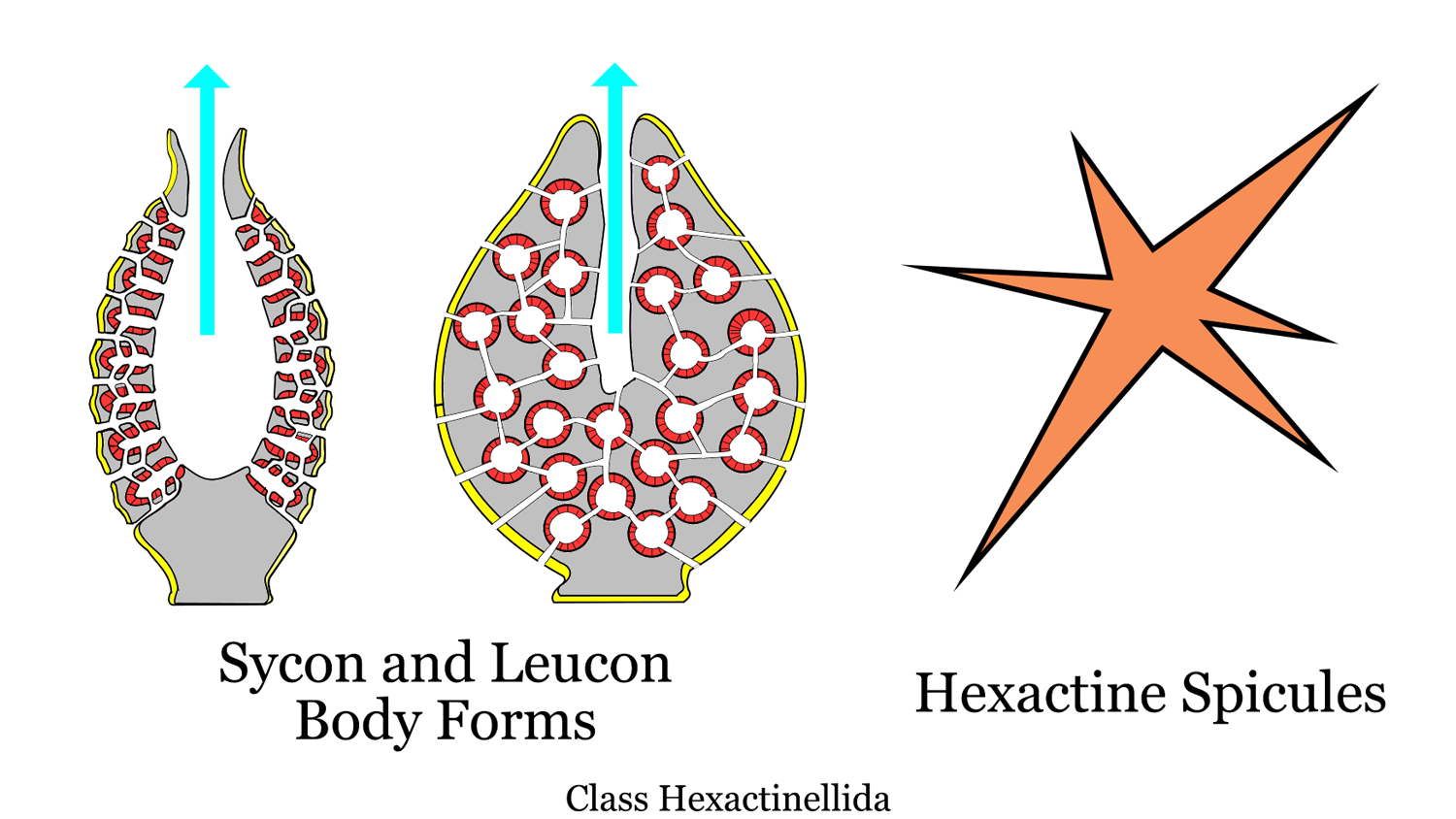
Sponge sycon and leucon body plans modified from original image by 'Philcha' (Wikimedia Commons; Creative Commons Attribution-Share Alike 3.0 Public Domain Dedication). Spicule image by Jaleigh Q. Pier is licensed under a Creative Commons Attribution-ShareAlike 4.0 International License.
Modern hexactinellid sponges are largely restricted to deep-sea habitats (200 to >6000m). Fossilized hexactinellids, however, seem to have been distributed across a wider range of environments (Van Soest, 2012). Many glass sponges have holdfasts of spicule mats or rope-like structures, which allow them to inhabit soft muddy substrates of deeper depths.
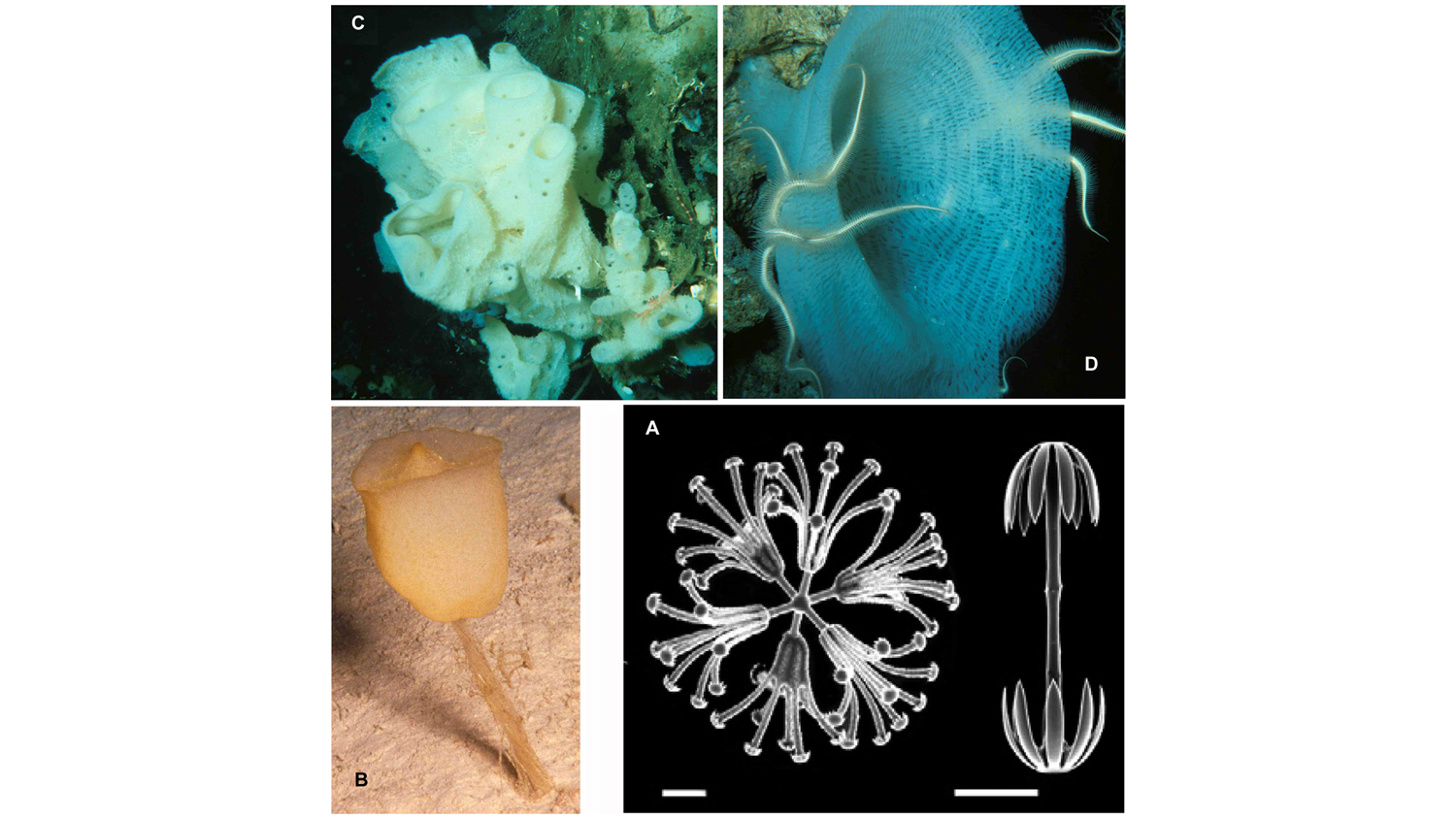
Hexactinellida Diversity. Original caption: "A. Scanning electron micrographs of microscleres (courtesy of H.M. Reiswig), left: a hexaster, the diagnostic spicule type of subclass Hexasterophora (scale bar = 10 µm), right: an amphidisc, the diagnostic spicule type of subclass Amphidiscophora (scale bar = 100 µm); B. Hyalonema sp., an amphidiscophoran (Amphidiscosida: Hyalonematidae), Bahamas; C. Atlantisella sp., a lyssacine hexasterophoran (Lyssacinosida: Euplectellidae), Galapagos Islands; D. Lefroyella decora, a dictyonal hexasterophoran (“Hexactinosida”: Sceptrulophora: Euretidae), Bahamas. B–D courtesy of Harbor Branch Oceanographic Institute (Ft. Pierce, Florida, U S A), images taken from manned submersible Johnson-Sea-Link II." (Van Soest et al., 2012; Creative Commons Attribution-Share Alike 2.5 License).
Although glass sponges arose in the Cambrian, they reached their peak diversity in the Cretaceous, a time when sponges in general achieved their greatest diversity.
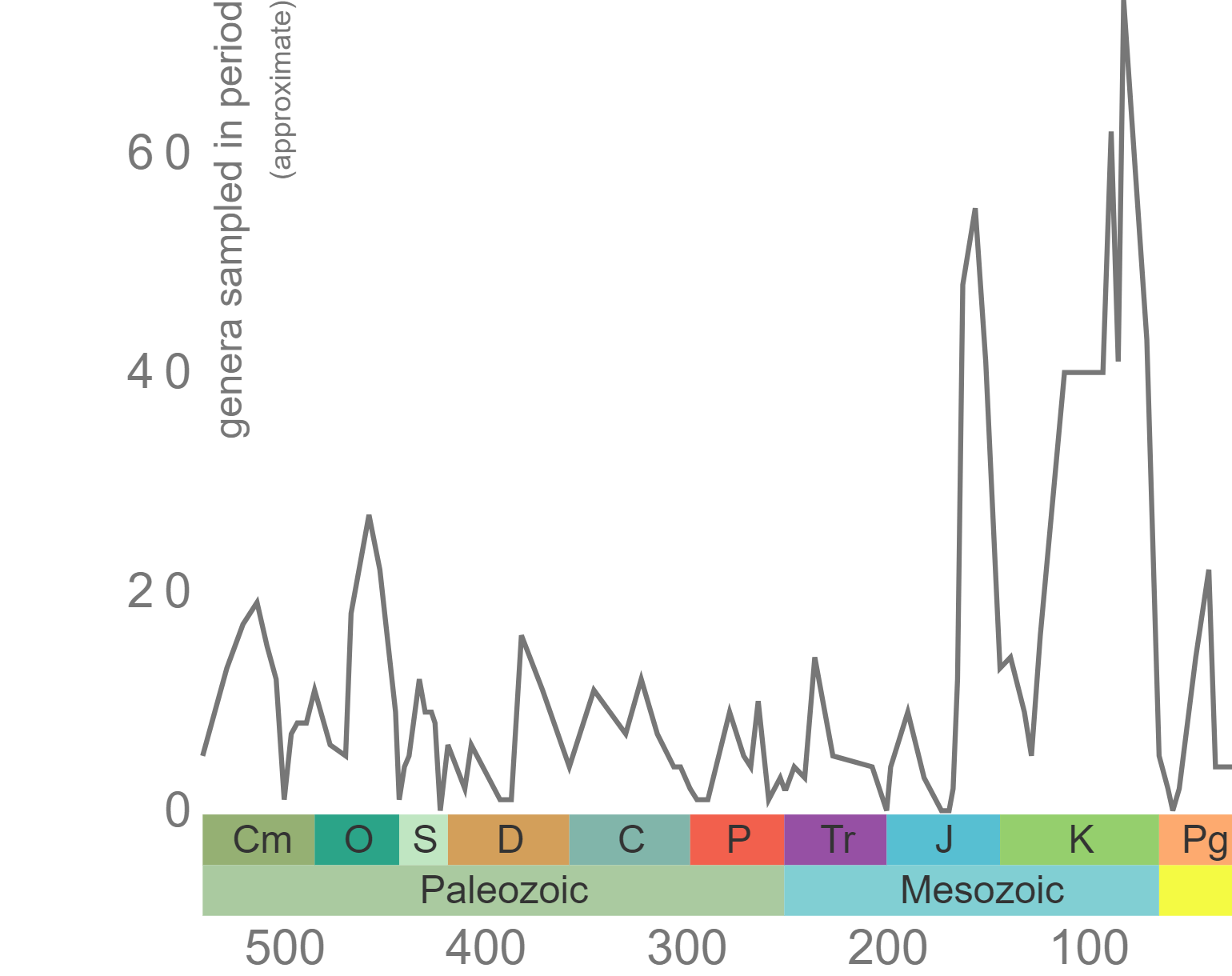
Phanerozoic genus-level diversity of Hexactinellida (graph generated using the Paleobiology Database Navigator).
Largest Living Sponge Reefs
Large glass sponge reefs occur in the fossil record and were thought to be extinct until some were discovered in the 1980s. Some of the largest living sponge reefs exist off the Canadian westcoast. At least seven different hexactinellid species make up the only extant siliceous sponge reefs, which reach bioherm heights of up to 19 meters. Some of these have been living for more than 9000 years in some spots (Krautter et al. 2001). Check out some live footage of these spectacular reefs below!
Source: "The Immortal Glass Sponge" by Ocean Wise
Engineering Examples
Engineers are finding new ways to apply sponge materials and characteristics to the development of new products. Architects are mimicking the mechanical strength of sponge spicules in their building designs. The cross-hatched appearance of the glass sponge fossil shown below represents one of the strongest forms of natural architecture. Civic engineers have designed skyscrapers with similar supports, the Eiffel Tower in Paris being a characteristic example.
Fossil specimen of the glass sponge Hydnoceras tuberosum from the Devonian of Steuben County, New York (PRI 76741). Specimen is from the collections of the Paleontological Research Institution, Ithaca, New York. Length of specimen is approximately 26 cm.
Our modern world runs on fiber optic networks. Fiber optic cables contain strands of glass which are extremely efficient at transmitting data and telecommunications at higher levels and speeds than traditional wire cables. It turns out that glass sponges naturally create glass fiber spicules that may be even more efficient than those created by humans and researchers are interested in synthesizing glass that is similar to that naturally constructed by these sponges. Needless to say, this is a promising area of research as society becomes increasingly dependent on data-driven technology.
The Most Famous Glass Sponge
The venus flower basket (Euplectella aspergillum) is a popular wedding gift in Asian cultures. Often enclosed inside the sponge fibers is a mated pair of shrimp (Stenopodidea), which become trapped inside for life while the sponge grows around them. After the mating pair breeds, tiny offspring escape to inhabit their own venus flower baskets. This is a symbiotic relationship: the sponge provides safe housing, while the shrimp in turn clean and maintain the sponge (Van Soest 2012).
These little "Prisoners of Love" symbolize a lifetime bond between two committed partners.
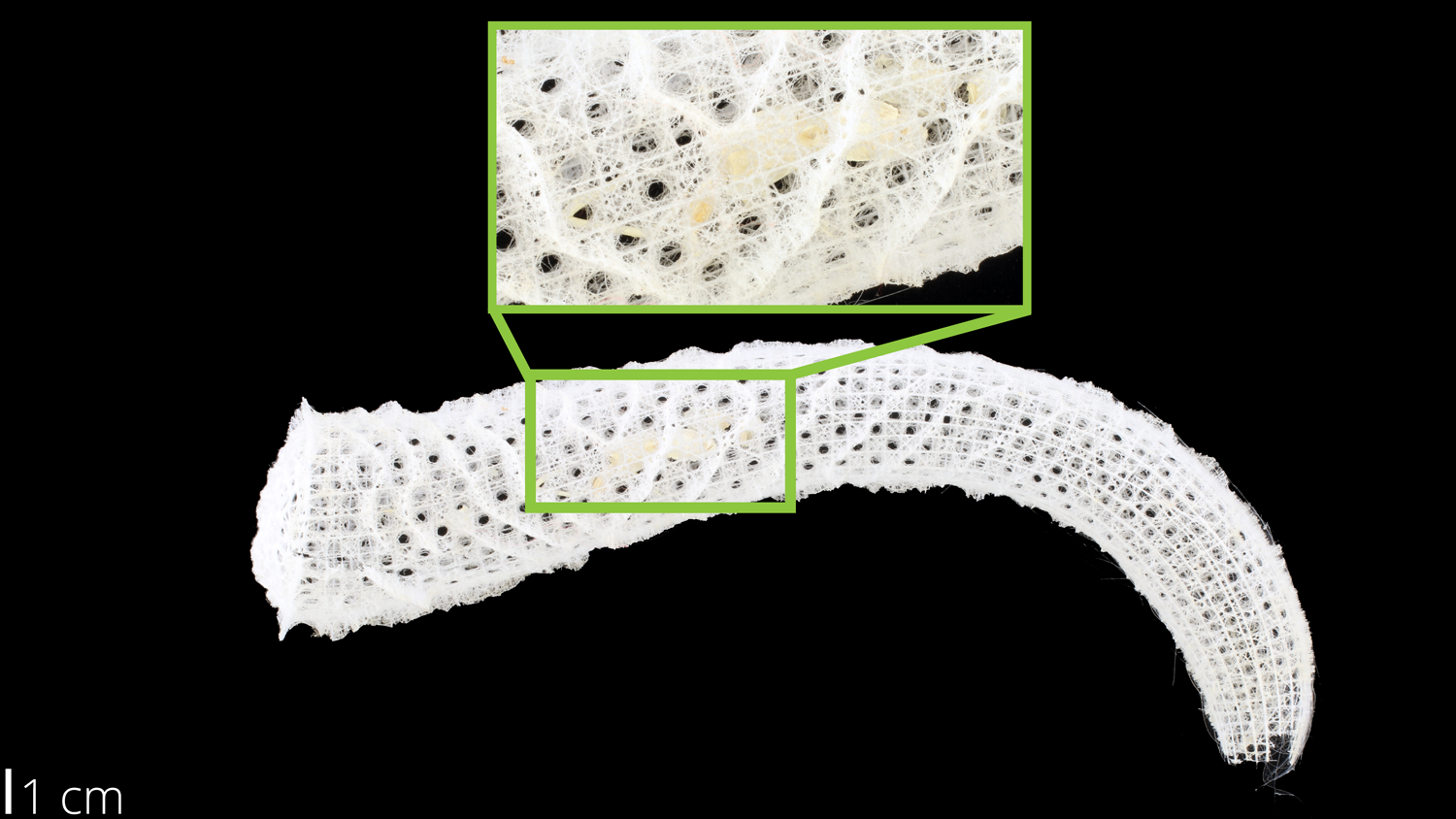
Modern specimen of the glass sponge Euplectella aspergillum with invertebrate remains inside. Specimen from the collections of the Paleontological Research Institution in Ithaca, NY. Image by Jaleigh Q. Pier is licensed under a Creative Commons Attribution-ShareAlike 4.0 International License.
Modern specimen of the glass sponge Euplectella sp., also known as “Venus’ Flower Basket” (locality information not available). Specimen is from the teaching collections of the Paleontological Research Institution. Length of specimen is approximately 22 cm.
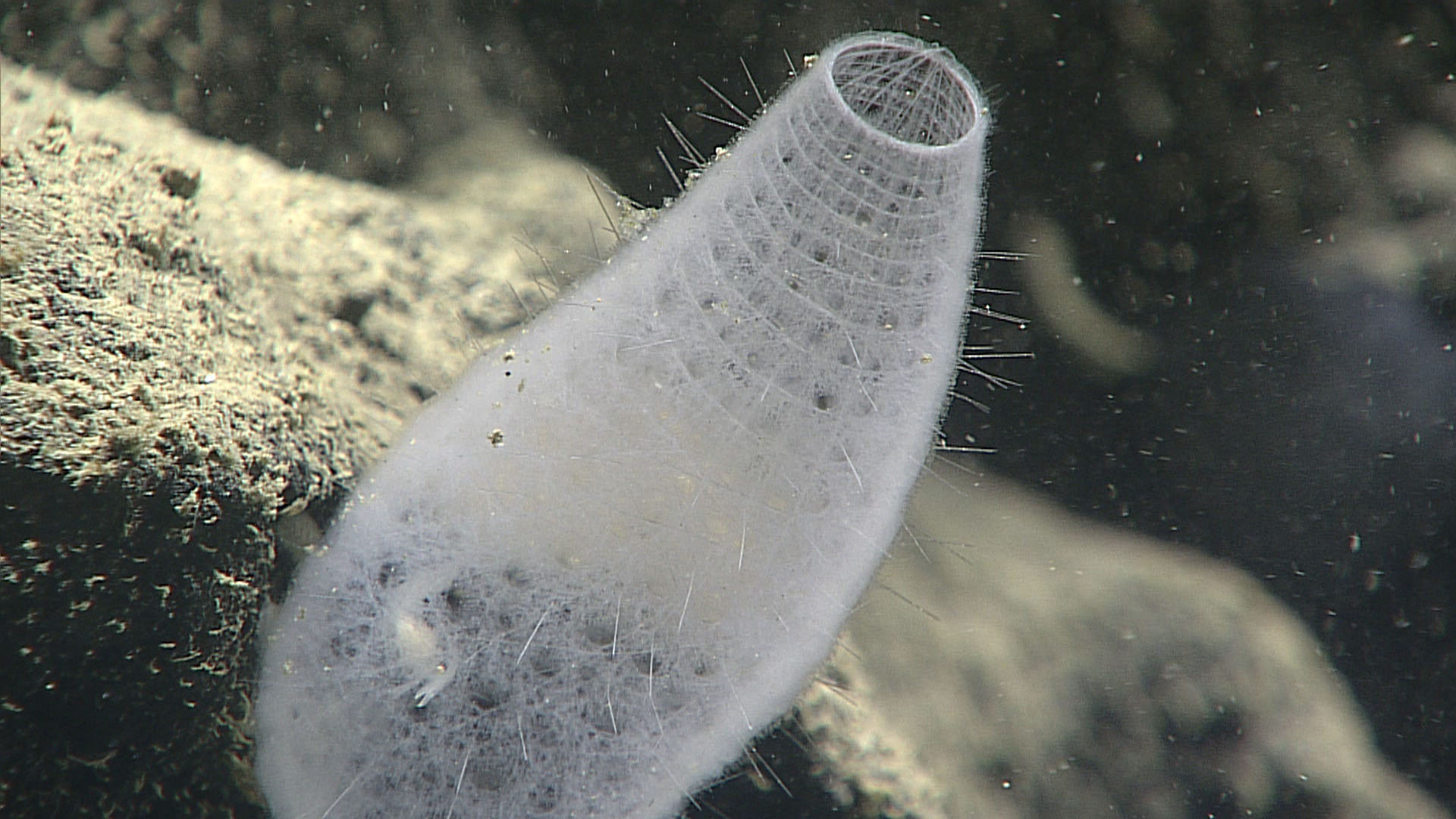
Euplectellid vase sponge with trapped life-long shrimp seen inside. Family Euplectellidae, Dictyaulus sp. Source: NOAA Okeanos Explorer Program, 2016 Deepwater Exploration of the Marianas, Leg 3 (Wikimedia Commons, Creative Commons Attribution 2.0 Generic License)
Source: "Blue Planet II" by BBC America
Living Hexactinellida

A stalked glass sponge. Source: NOAA Okeanos Explorer Program, Gulf of Mexico 2012 Expedition (Public Domain)
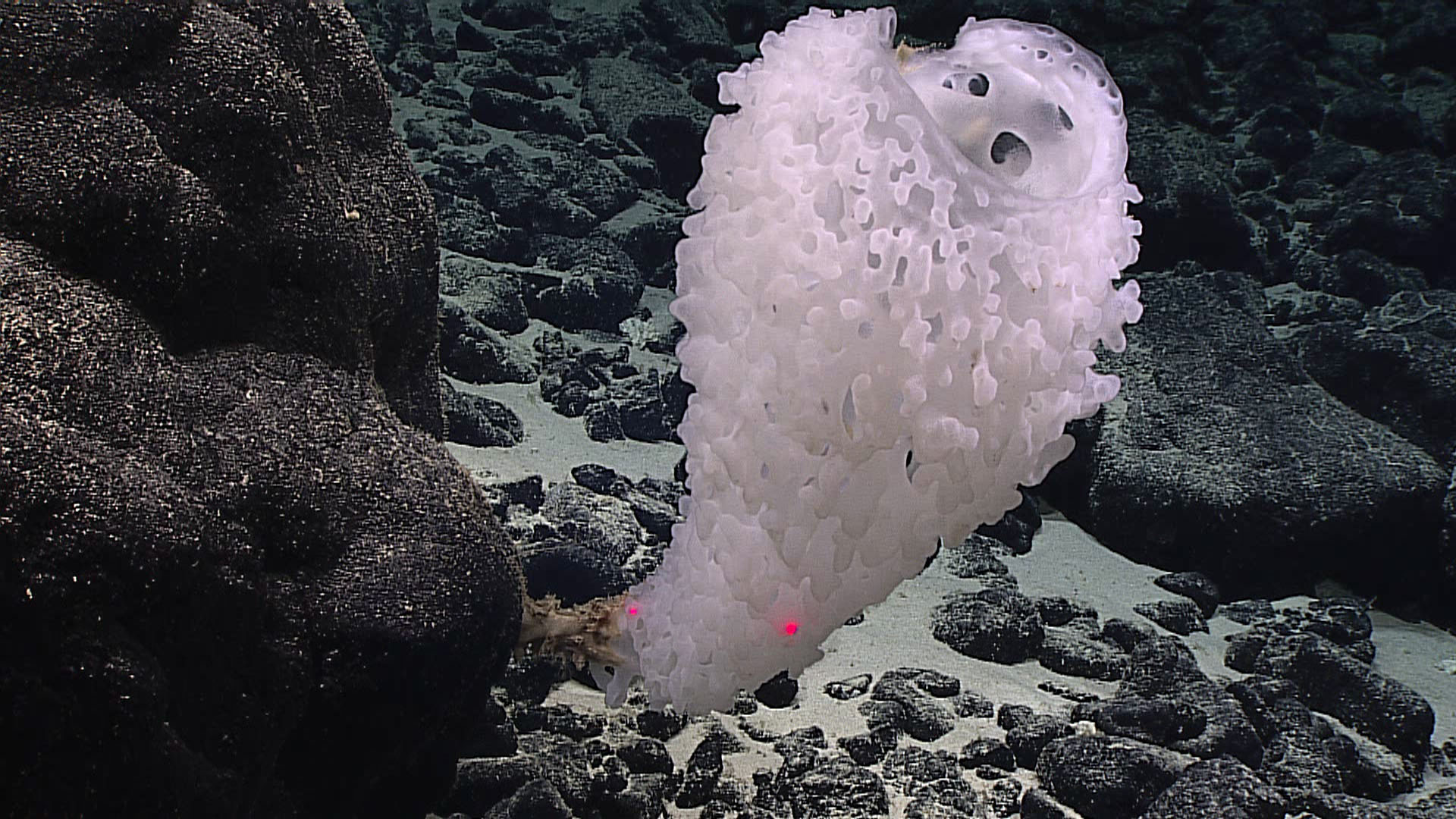
Source: NOAA/OAR/OER, 2016 Deepwater Wonders of Wake (Public Domain)
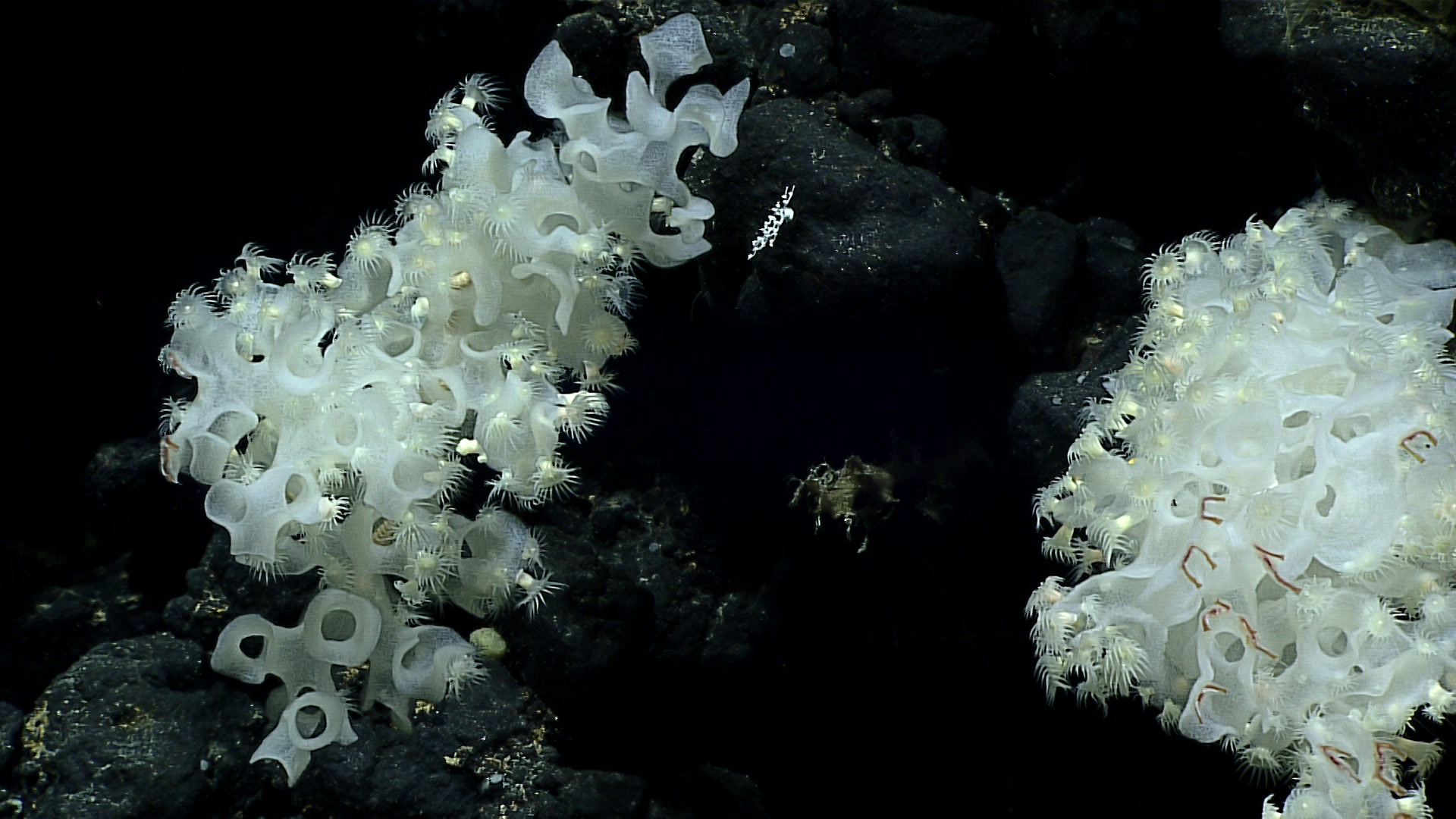
A glass sponge (Farreidae). Source: NOAA/OAR/OER, 2016 Deepwater Exploration of the Marianas, Leg 1. (Public Domain)
Fossil Hexactinellida
Fossil specimen of the glass sponge Uphantaenia chemungensis from the Devonian Enfield Formation of Tompkins County, New York (PRI 76745). Specimen is from the collections of the Paleontological Research Institution, Ithaca, New York. Maximum diameter of specimen (not including surrounding rock matrix) is approximately 11.5 cm.
Fossil specimen of the glass sponge Coeloptychium agaricoides from the Upper Cretaceous of Hannover, Germany (PRI 70599). Specimen is from the research collections of the Paleontological Research Institution, Ithaca, New York. Specimen is approximately 11 cm in diameter.
Fossil specimen of the glass sponge Trochobolus cylindratus from the Jurassic of Zalas, Poland (PRI 76848). Specimen is from the research collections of the Paleontological Research Institution, Ithaca, New York. Length of specimen is approximately 7.5 cm.
References and further reading:
Aizenberg, J., Weaver, J., Thanawala, M.S., Sundar, V.C., Morse, D.E., Fratzl, P. 2005. Skeleton of Euplectella sp: Structural hierarchy from the nanoscale to the macroscale. Science 309: 275-278.
Boardman, R.S., Cheetham, A.H., and Rowell, A.J. 1987. Fossil Invertebrates. Blackwell Scientific Publications. 713 pp.
Botting, J.P, and Muir, L.A. 2018. Early sponge evolution: A review and phylogenetic framework. Palaeoworld: 27, pp. 1-29.
Brusca, R.C., and G.J. Brusca. 2002. Invertebrates Second Edition. Sinauer Associates Inc. Publishers, Sunderland MA. 936 pp.
Dohrmann, M. et al. 2017. An integrative systematic framework helps to reconstruct skeletal evolution of glass sponges (Porifera, Hexactinellida). Frontiers in Zoology: 14, pp. 1-31.
Hogg, et al. 2010. Deep-sea sponge grounds: Reservoirs of biodiversity. UNEP-WCMC Biodiversity Series No. 32. UNEP-WCMC, Cambridge, UK.
Krautter, M., et al. 2001. Discovery of a “Living Dinosaur”: Globally unique modern hexactinellid sponge reefs off British Columbia, Canada. Facies: 44(1), 265-282.
Reiswig, H.M. 1979. Histology of Hexactinellida (Porifera). In C. Levi and N. Boury-Esnault, editors. Sponge Biology, Colloques International C.N.R.S. 291: 173-180.
Van Soest, R.W.M., et al. 2012. Global Diversity of Sponges (Porifera). PLoS ONE: 7(4), pp. 1-23.
Usage

Unless otherwise indicated, the written and visual content on this page is licensed under a Creative Commons Attribution-NonCommercial-ShareAlike 4.0 International License. This page was written by Jaleigh Q. Pier. See captions of individual images for attributions. See original source material for licenses associated with video and/or 3D model content.



